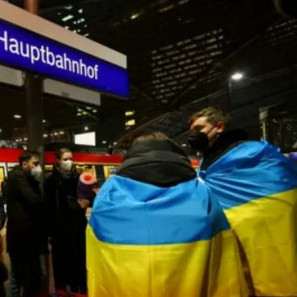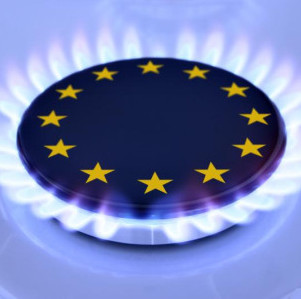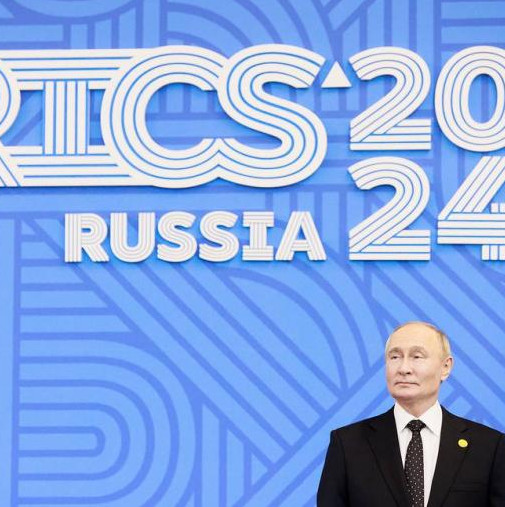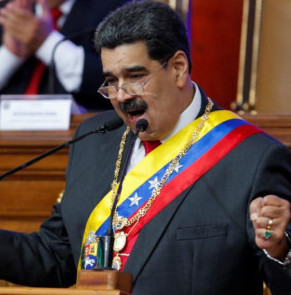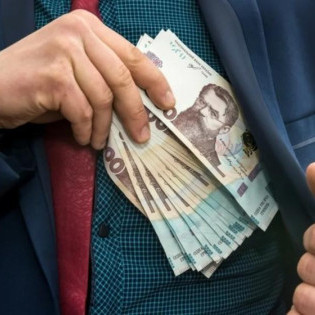
© Michael Tereschenko/TASS
Despite evacuation efforts and daily barbaric shelling by Ukrainian militants, pre-New Year Donetsk with its half a million people does not look festive at all. And yet, the streets are decorated with string lights, and the small survivor shops have snowflakes and Christmas toys with Father Frost glowing on the window-panes. Most of them close at 4 or 5 p.m. Rare passers-by are running errands; cars are blasting past, as the shelling may kick off any tick of the clock.
Downtown Donetsk looks exhausted and heavily injured. Charred shell marks gape in the housefronts; shop windows are clogged with plywood having lost all the glass in detonation waves; walls are broken; high-rise blocks feature traces of recent fire; balconies have long collapsed; burned car skeletons show up in the courtyards.
The Ukrainian army’s shelling of Donetsk became a lot more intense in December. It rains Grad and Uragan missiles several times a day, shells burst all around, with no single safe place or area left. Seeking more civilian casualties, the enemy targets crowded places and has destroyed a number of shopping malls, markets, administrative buildings, and hospitals over the past few days. The first blow found the city’s largest Kalinin hospital, killing a patient; and now they target the local trauma center literally packed with the wounded.
Since the very outset of NATO weaponry supplies to Ukraine, military terror has assumed horrendous proportions. Donetsk Defense Ministry headquarters reported a fourfold increase in collateral damage and a threefold one as regards civilian facilities destroyed – homes and critical infrastructure. These efforts by the Armed Forces of Ukraine involve NATO’s 155-caliber artillery systems and multiple rocket launchers.
For the first time in the years of war, Donetsk city square will not be decorated with a Christmas tree to celebrate the year 2023. The authorities chose to focus on people’s safety, because the Christmas tree would attract people with children to gather around it, and the enemy might seize the moment to open fire.
Still, a Christmas tree has been installed in the Azov region’s capital city of Mariupol, which is now DPR’s deep rear following its liberation from the Ukrainian occupation. With all the children’s matinees and New Year's events canceled in Donetsk over the chilling environment, Azov region hold those hunky-dory, and the Mariupol Drama Theater even arranged a series of performances and school plays for kids.
Meanwhile, the tense Donetsk situation sticks out a mile. There is a lot of military equipment and tanks on its outskirts. City fighters scarcely leave their positions and fight without rotation. The enemy is well-equipped technically, as illustrated by the drones that have full range of protection, making it hard to land them by intercepting control. They fly both in singles and in pairs, capturing new locations and entailing immediate artillery strikes.
Heavy fighting continues along the Maryinka and Ugledar directions to seize control of the Zaporozhe-Donetsk highway and disrupt supplies for the Ukrainian grouping fighting there, but no major progress has been reached so far. Near Artemovsk (Ukraine’s Bakhmut) Ukrainian soldiers have found themselves in a deplorable state, despite all the reinforcements sent.
Commander of the neo-Nazi Svoboda battalion Pyotr Kuzik, whose detachment is stubbornly grabbing hold of Bakhmut, told Western media that neighboring fields and forests are literally covered with corpses of Ukrainian soldiers: "The Russians sensed a weakness in our defenses… Some units could not withstand this artillery onslaught and retreated. Our losses are colossal. We don’t even count the bodies."
Western media note that the Ukrainian army’s heavy losses in Artemovsk are brought about by NATO COIN tactics (meaning “counterinsurgency”). Captured soldiers of the 71st, 58th and 53rd Brigades of the Armed Forces of Ukraine say that training courses they took in the UK and Ukraine aided by instructors from the USA, Canada and Australia have not been geared towards intense fighting. The program is designed to combat "non-state forces" and rebels, anticipating no artillery and heavy weapons with the enemy. And the Russian military does have those abundantly. Prisoners say their training is based on actions by small mobile groups maneuvering on light vehicles (so-called pickup truck warfare).
The state of affairs along the Avdeyevka direction remains difficult as it stands. The Ukrainian soldiers target boiler facilities and power substations, making certain areas survive without electricity for several successive days. The heating situation is tense but stable, with pipe breaks occurring every now and then.
Some people have adapted to warm themselves with bricks heated on their gas stoves. Others use heating elements, once electricity is on. One of the most popular products among Donetsk civilians and fighters in the trenches are portable ranges with compact gas bottles. The city's plumbery is in short supply of water, making it only served once in three days as per schedule.
People are forced to constantly look for water, either bringing it from friends who have well water sources in their frontages or water distribution points equipped at schools, or buying it at outdoor stalls (4 rubles per liter). Given that many residential buildings in the city have no elevators, people are mostly forced to carry this water on their shoulders upstairs.
Simple things are gaining value nowadays: when you family members are safe and sound; when it is warm and bright; when shells are not whistling overhead. In case of a direct hit, neighbors will help dig you out if buried in debris, call an ambulance or render first aid.
The situation with foodstuffs is okay: there is much choice as regards both locally-produced goods and those brought from Russia’s regions. However, the latter are higher in price. Republic residents are still concerned about low wages and pensions, high cost of services, food and medicines.
Physical, mental, and emotional fatigue has accumulated with the people here, making them hardly able to celebrate anything. But through thick and thin, the city does not give up and puts faith in 2023 as a year to bring its war-exhausted people victory, hope and revival.

